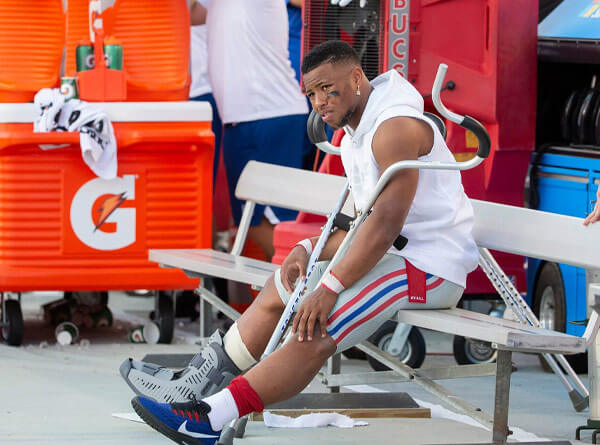High Ankle Sprains in NFL Athletes

By Krizha Adona, SPT
American football athletes tend to get injured fairly often because it is a high contact sport and it requires great physical demands. High ankle sprains are one of the most common injuries that athletes may acquire during their careers. Sam Darnold of the New York Jets, Saquon Barkley of the New York Giants and Quandre Diggs of Seattle Seahawks are just some of the long list of people from the NFL that recently had high ankle sprain.
What exactly is a high ankle sprain? A high ankle sprain can be acquired by excessively rotating the foot in an outward direction (external rotation) while the foot is positioned in dorsiflexion. It can also be acquired if the foot is planted on the ground and the athlete turns his lower leg (tibia and fibula) in an inward direction, or by getting a direct blow on the lateral (outer) aspect of the leg while the foot is planted on the ground. This causes causes injury to the syndesmotic ligaments just above the ankle joint.1 The syndesmotic ligaments act as stabilizers and shock absorbers of the ankle joint 2, and if damaged, can cause instability. It is important to differentiate this injury to a more common sprain called the lateral ankle sprain as they have some differences in treatment approach and length of recovery time. A lateral ankle sprain is acquired when you excessively plantarflex and invert your foot (roll your ankle) causing injury to the lateral ligaments of the ankle.
How is this injury diagnosed? A physical therapist will take a thorough history to determine the mechanism of how the injury was acquired. During the physical examination, the therapist will palpate for tenderness around the ankle, and inspect it for swelling. The tenderness and/or pain is often diffuse but is typically located anterolaterally and/or posteromedially at the level of the ankle joint.1 Special provocative tests can also be utilized to confirm the diagnosis, as well as imaging such as X-ray or MRI.2
High ankle sprains are classified using 3 different grades, which depend on severity. Grade I is clinically mild, the ankle is stable, and radiographic findings appear normal. Grade II is typically associated with partial damage to the syndesmotic ligaments, and radiographic findings appear normal. It can present as a stable or unstable joint, and it should be assessed for confirmation. Lastly, a Grade III high ankle sprain include complete injury to the syndesmotic ligaments, plain radiography shows clear widening of the space between the tibia and fibula, and it commonly occurs with fractures or other injuries. 1 The higher the grade of the ankle sprain is, the longer it will take for an athlete to return to sports. 3
High ankle sprains are usually treated conservatively with physical therapy. However, if imaging shows that there is significant damage to the supporting ligaments causing instability of the ankle joint, and if there is syndesmotic widening >2mm, surgery is often necessary. Screws, suture buttons or a combination of both can be used as fixation devices to provide and re-establish stability to the ankle joint. Fixation is also indicated if conservative management was utilized but has failed. 1
If an athlete’s injury requires a surgical approach, postoperative care includes: (1) immobilization with no weight bearing permitted for 4 to 6 weeks, (2) introduction of range of motion exercises and resistance training a few days after surgery, (3) progressive weight bearing in a boot and strengthening exercises under close supervision, (4) and lastly, depending on severity of injury, an athlete can return to sport at 10 to 12 weeks.1 If an athlete’s injury does not require a surgical approach, a 3-phase rehabilitation program can be utilized. Phase 1 (acute phase) focuses on protecting the joint while minimizing pain, inflammation, weakness and loss of motion. Phase 2 (subacute phase) focuses on normalizing joint mobility, strength, neuromuscular control, and return to basic function in activities of daily living. Phase 3 (advanced training) concentrates on preparing the athlete to return to sports.
References
- Hunt K, Phisitkul P, Pirolo J, Amendola A. High Ankle Sprains and Syndesmotic Injuries in Athletes. Journal of the American Academy of Orthopaedic Surgeons. 2015;23(11):661-673. doi:10.5435/jaaos-d-13-00135
- Williams GN, Allen EJ. Rehabilitation of syndesmotic (high) ankle sprains. Sports Health. 2010;2(6):460–470. doi:10.1177/1941738110384573
- Sikka R, Fetzer G, Sugarman E et al. Correlating MRI Findings with Disability in Syndesmotic Sprains of NFL Players. Foot Ankle Int. 2012;33(5):371-378. doi:10.3113/fai.2012.0371a
